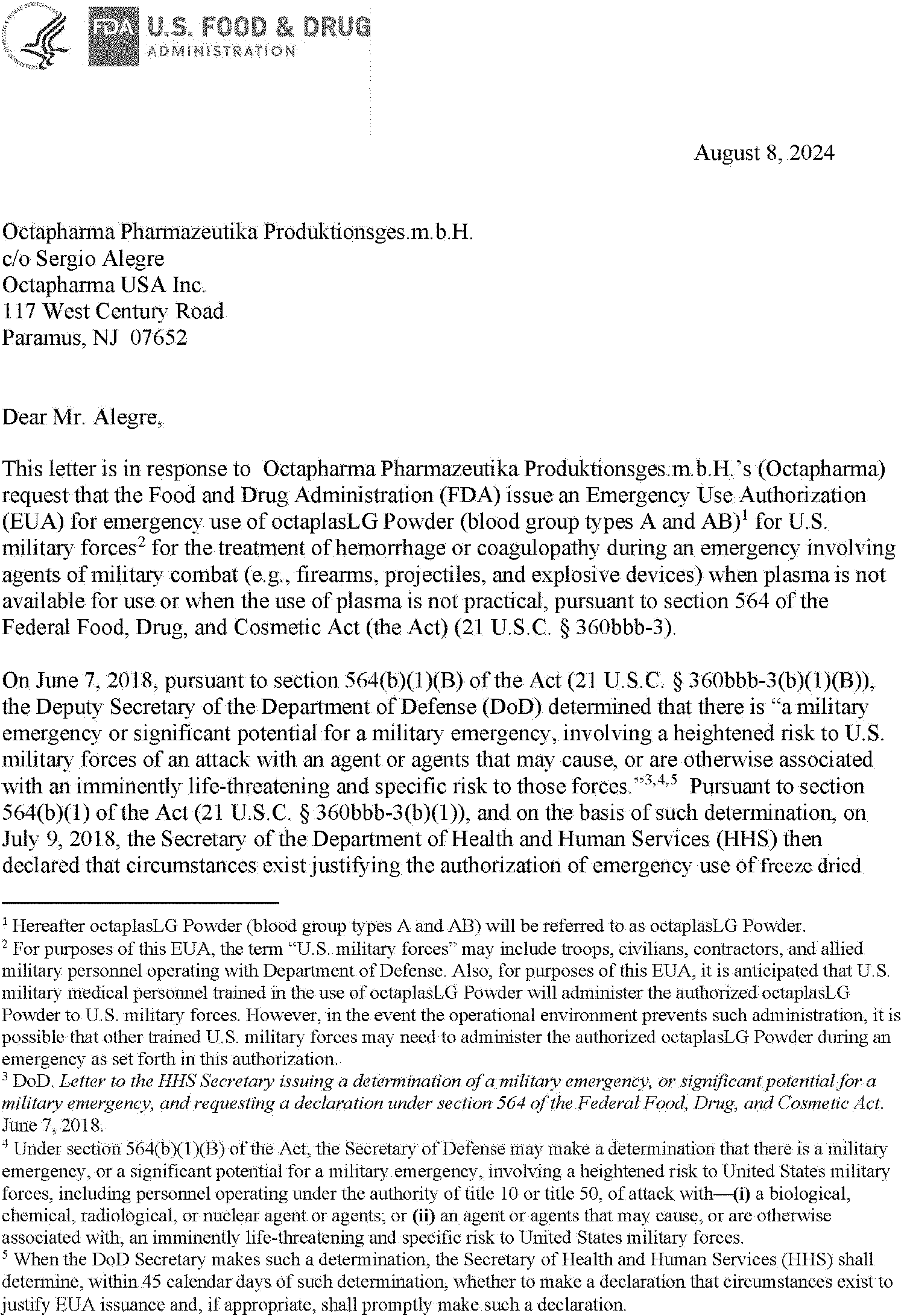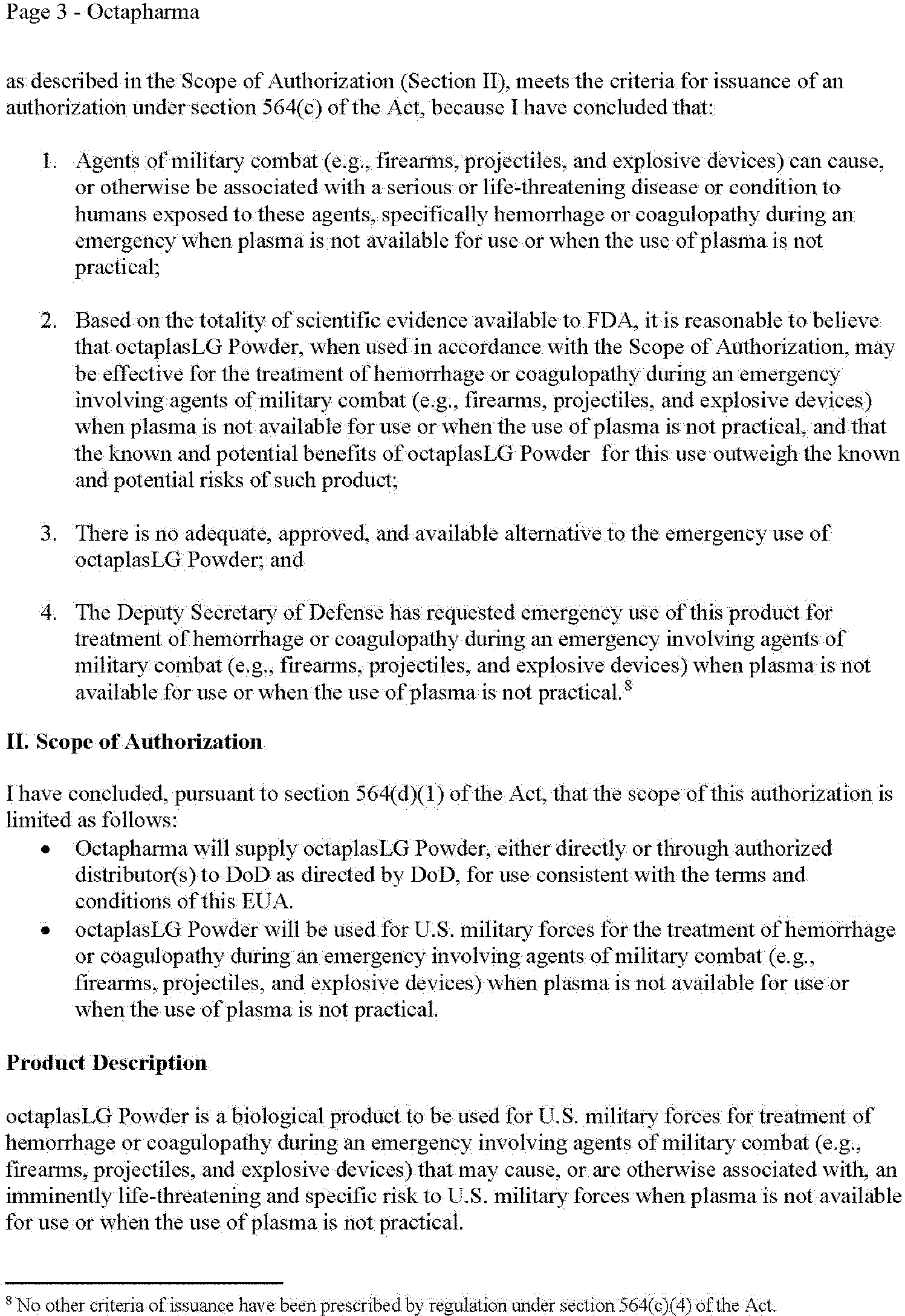2024-18971. Authorization of Emergency Use of a Freeze-Dried Plasma Product for Treatment of Hemorrhage or Coagulopathy During an Emergency Involving Agents of Military Combat; Availability
-
AGENCY:
Food and Drug Administration, HHS.
ACTION:
Notice.
SUMMARY:
The Food and Drug Administration (FDA) is announcing the issuance of an Emergency Use Authorization (EUA) (the Authorization) under the Federal Food, Drug, and Cosmetic Act (FD&C Act) for use of a freeze-dried plasma product, octaplasLG Powder, for emergent treatment of hemorrhage or coagulopathy during an emergency involving agents of military combat ( e.g., firearms, projectiles, and explosive devices) when plasma is not available for use or when the use of plasma is not practical.
DATES:
The Authorization is effective as of August 8, 2024.
ADDRESSES:
Submit written requests for single copies of the EUA to the Office of Communication, Outreach and Development, Center for Biologics Evaluation and Research, Food and Drug Administration, 10903 New Hampshire Ave. Bldg. 71, Rm. 3128, Silver Spring, MD 20993-0002. Send one self-addressed adhesive label to assist the office in processing your request or include a fax number to which the Authorization may be sent. See the SUPPLEMENTARY INFORMATION section for electronic access to the Authorization.
FOR FURTHER INFORMATION CONTACT:
Andrew C. Harvan, Center for Biologics Evaluation and Research, Food and Drug Administration, 10903 New Hampshire Ave. Bldg. 71, Rm. 7301, Silver Spring, MD 20993-0002, 240-402-7911.
SUPPLEMENTARY INFORMATION:
I. Background
Section 564 of the FD&C Act (21 U.S.C. 360bbb-3) as amended by the Project BioShield Act of 2004 (Pub. L. 108-276), the Pandemic and All-Hazards Preparedness Reauthorization Act of 2013 (Pub. L. 113-5), 21st Century Cures Act (Pub. L. 114-255), and Public Law 115-92 (2017), allows FDA to strengthen the public health protections against biological, chemical, nuclear, and radiological agents and other agents that may cause, or are otherwise associated with, an imminently life-threatening and specific risk to U.S. military forces. Among other actions, section 564 of the FD&C Act allows FDA to authorize the use of an unapproved medical product or an unapproved use of an approved medical product in certain situations. With this EUA authority, FDA can help ensure that medical countermeasures may be used in emergencies to diagnose, treat, or prevent serious or life-threatening diseases or conditions caused by biological, chemical, nuclear, or radiological agents and other agents that may cause, or are otherwise associated with, an imminently life-threatening ( print page 68626) and specific risk to U.S. military forces when there are no adequate, approved, and available alternatives (among other criteria).
II. Criteria for EUA Authorization
Section 564(b)(1) of the FD&C Act provides that, before an EUA may be issued, the Department of Health and Human Services (HHS) Secretary must declare that circumstances exist justifying the authorization based on one of the following grounds: (1) a determination by the Secretary of Homeland Security that there is a domestic emergency, or a significant potential for a domestic emergency, involving a heightened risk of attack with a biological, chemical, radiological, or nuclear agent or agents; (2) a determination by the Secretary of Defense that there is a military emergency, or a significant potential for a military emergency, involving a heightened risk to U.S. military forces, including personnel operating under the authority of title 10 or title 50, United States Code, of attack with (i) a biological, chemical, radiological, or nuclear agent or agents; or (ii) an agent or agents that may cause, or are otherwise associated with, an imminently life-threatening and specific risk to U.S. military forces; [1] (3) a determination by the Secretary of HHS that there is a public health emergency, or a significant potential for a public health emergency, that affects, or has a significant potential to affect, national security or the health and security of U.S. citizens living abroad, and that involves a biological, chemical, radiological, or nuclear agent or agents, or a disease or condition that may be attributable to such agent or agents; or (4) the identification of a material threat by the Secretary of Homeland Security under section 319F-2 of the Public Health Service (PHS) Act (42 U.S.C. 247d-6b) sufficient to affect national security or the health and security of U.S. citizens living abroad.
Once the Secretary of HHS has declared that circumstances exist justifying an authorization under section 564 of the FD&C Act, FDA may authorize the emergency use of a drug, device, or biological product if the Agency concludes that the statutory criteria are satisfied. Under section 564(h)(1) of the FD&C Act, FDA is required to publish in the Federal Register a notice of each authorization, and each termination or revocation of an authorization, and an explanation of the reasons for the action. Under section 564(h)(1) of the FD&C Act, revisions to an authorization shall be made available on the internet website of FDA. Section 564 of the FD&C Act permits FDA to authorize the introduction into interstate commerce of a drug, device, or biological product intended for use when the Secretary of HHS has declared that circumstances exist justifying the authorization of emergency use. Products appropriate for emergency use may include products and uses that are not approved, cleared, or licensed under sections 505, 510(k), 512, or 515 of the FD&C Act (21 U.S.C. 355, 360(k), 360b, and 360e) or section 351 of the PHS Act (42 U.S.C. 262), or conditionally approved under section 571 of the FD&C Act (21 U.S.C. 360ccc).
FDA may issue an EUA only if, after consultation with the HHS Assistant Secretary for Preparedness and Response, the Director of the National Institutes of Health, and the Director of the Centers for Disease Control and Prevention (to the extent feasible and appropriate given the applicable circumstances), FDA [2] concludes: (1) that an agent referred to in a declaration of emergency or threat can cause a serious or life-threatening disease or condition; (2) that, based on the totality of scientific evidence available to FDA, including data from adequate and well-controlled clinical trials, if available, it is reasonable to believe that: (A) the product may be effective in diagnosing, treating, or preventing (i) such disease or condition or (ii) a serious or life-threatening disease or condition caused by a product authorized under section 564, approved or cleared under the FD&C Act, or licensed under section 351 of the PHS Act, for diagnosing, treating, or preventing such a disease or condition caused by such an agent; and (B) the known and potential benefits of the product, when used to diagnose, prevent, or treat such disease or condition, outweigh the known and potential risks of the product, taking into consideration the material threat posed by the agent or agents identified in a declaration under section 564(b)(1)(D) of the FD&C Act, if applicable; (3) that there is no adequate, approved, and available alternative to the product for diagnosing, preventing, or treating such disease or condition; (4) in the case of a determination described in section 564(b)(1)(B)(ii) of the FD&C Act, that the request for emergency use is made by the Secretary of Defense; and (5) that such other criteria as may be prescribed by regulation are satisfied.
No other criteria for issuance have been prescribed by regulation under section 564(c)(4) of the FD&C Act.
III. The Authorization
On June 7, 2018, the Deputy Secretary of Defense determined that “there is a military emergency or significant potential for a military emergency, involving a heightened risk to U.S. military forces of an attack with an agent or agents that may cause, or are otherwise associated with an imminently life-threatening and specific risk to those forces.” The Deputy Secretary of Defense further stated that, “[m]ore specifically, U.S. [f]orces are now deployed in multiple locations where they serve at heightened risk of an enemy attack with agents of military combat, including firearms, projectiles, and explosive devices, that may cause major and imminently life-threatening combat casualties involving uncontrolled hemorrhage.” On July 9, 2018, under section 564(b)(1) of the FD&C Act, and on the basis of such determination, the Secretary of HHS declared that circumstances exist justifying the authorization of emergency use of freeze-dried plasma for the treatment of hemorrhage or coagulopathy during an emergency involving agents of military combat ( e.g., firearms, projectiles, and explosive devices) when plasma is not available for use or when the use of plasma is not practical, subject to the terms of any authorization issued under section 564 of the FD&C Act. Notice of the declaration of the Secretary of HHS was published in the Federal Register on July 16, 2018 (83 FR 32884) and a correction was published in the Federal Register on July 31, 2018 (83 FR 36941).
On February 22, 2024, Octapharma Pharmazeutika Produktionsges.m.b.H. (Octapharma) submitted a complete EUA request for octaplasLG Powder. Having concluded that the criteria for issuance of the Authorization under section 564(c) of the FD&C Act are met, on August 8, 2024, FDA issued an EUA for octaplasLG Powder, manufactured by Octapharma, subject to the terms of the Authorization. The Authorization in its entirety (not including the authorized versions of the fact sheets and other written materials) follows and provides an explanation of the reasons for issuance, as required by section 564(h)(1) of the FD&C Act.
IV. Electronic Access
An electronic version of this document and the full text of the ( print page 68627) Authorization are available on the internet at https://www.regulations.gov.
( print page 68628) ( print page 68629) ( print page 68630) ( print page 68631) ( print page 68632) ( print page 68633) ( print page 68634) ( print page 68635)( print page 68636)Dated: August 20, 2024.
Lauren K. Roth,
Associate Commissioner for Policy.
Footnotes
1. In the case of a determination by the Secretary of Defense, the Secretary of HHS shall determine, within 45 calendar days of such determination, whether to make a declaration under section 564(b)(1) of the FD&C Act, and, if appropriate, shall promptly make such a declaration.
Back to Citation2. The Secretary of HHS has delegated the authority to issue an EUA under section 564 of the FD&C Act to the Commissioner of Food and Drugs.
Back to Citation
Document Information
- Effective Date:
- 8/8/2024
- Published:
- 08/27/2024
- Department:
- Food and Drug Administration
- Entry Type:
- Notice
- Action:
- Notice.
- Document Number:
- 2024-18971
- Dates:
- The Authorization is effective as of August 8, 2024.
- Pages:
- 68625-68636 (12 pages)
- Docket Numbers:
- Docket No. FDA-2024-N-3925
- PDF File:
- 2024-18971.pdf










